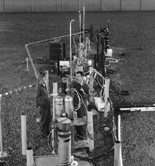 Microorganisms recruited for Hanford cleanup
Microorganisms recruited for Hanford cleanup 
 Microorganisms recruited for Hanford cleanup
Microorganisms recruited for Hanford cleanup Deep underground at the Hanford Site in southeastern Washington state, an army of microorganisms has been drafted by the U.S. Department of Energy's Pacific Northwest National Laboratory. The microorganisms' mission--to clean soils and ground water tainted with nitrate and carbon tetrachloride, an industrial solvent and a suspected carcinogen.
 The microorganisms are part of DOE's first large-scale test of in-situ or underground bioremediation at Hanford. In this pilot project, researchers are demonstrating the ability of microorganisms to clean up a one trillion liter (300 billion gallon) ground water plume contaminated with carbon tetrachloride, a residual of past plutonium
processing practices. Approximately 7.5 million liters (two million gallons) of ground water were processed during the field test.
The microorganisms are part of DOE's first large-scale test of in-situ or underground bioremediation at Hanford. In this pilot project, researchers are demonstrating the ability of microorganisms to clean up a one trillion liter (300 billion gallon) ground water plume contaminated with carbon tetrachloride, a residual of past plutonium
processing practices. Approximately 7.5 million liters (two million gallons) of ground water were processed during the field test.
In-situ bioremediation, as applied at Hanford, is based on the principle of biostimulation--supplying nutrients to indigenous microbes to stimulate their metabolic activity. The enzymes produced by the microbes then degrade contaminants. The microbes use acetate (a nutrient) as a substrate and nitrate (a contaminant) as an electron acceptor. In this process, nitrate is converted to nitrogen gas. Carbon tetrachloride is degraded co-metabolically, meaning that the microorganisms' enzymes used for the primary metabolism of acetate and nitrate also can degrade carbon tetrachloride. "We're finding that the natural organisms often have the ability to destroy contamination if they're stimulated properly by an extra nutrient or by a slight change in their environment." said Tom Brouns, PNNL volatile organic compounds product line manager for DOE's plumes focus area. "Otherwise it may take hundreds or even thousands of years for the degradation to occur."
In-situ bioremediation requires ground water to be recirculated to distribute nutrients through the aquifer. The demonstration site at Hanford consists of six wells, 91 meters (300 feet) deep, which are used to recirculate and monitor the ground water, and a trailer, which is the command center for the operation. The test site is about the area of a football field and is located in Hanford's 200 West Area. Housed in the trailer are computers that control nutrient injection, the sampling process, and injection equipment. At specific times, a precise amount of nutrient is injected into a well. "We're using a precise methodology to get the maximum performance out of the microbes," said PNNL Project Manager Dan Anderson. "If we get it wrong, we could grow a lot of biomass in the wrong place and plug a well."
The demonstration was conducted during 1995. During the first phase, researchers recirculated the ground water to establish baseline conditions. This included measuring the demonstration site's contaminant concentration, determining the number of native microorganisms, and testing the design of the recirculation/injection system. In the second phase of operation, researchers injected nutrients into the wells to increase the number of microorganisms used to destroy contaminates. The third phase ran in production mode for 70 days of sustained carbon tetrachloride destruction. During this phase of the field test, the following strategies were used.
Scientists are using findings from the field test to refine the bioremediation process and increase the performance of the microorganisms. Additional field testing was conducted in the fall of 1995 using a different test configuration at the same site. The additional testing provided more information on ways to enhance the distribution of microbial activity to effectively treat larger portions of the plume.
Bioremediation is expected to cost less than methods where ground water is pumped to the surface and treated above ground. "Attacking the contamination underground eliminates the expense of removing contaminated soil or water and treating it elsewhere," Anderson says. "In addition, in-situ bioremediation provides ultimate destruction of the contaminant, requires half the time for remediation, and reduces worker exposure."
At Hanford, a minimum of 573 metric tons (637 tons) of carbon tetrachloride was discharged--primarily between 1955 and 1973--to soil disposal facilities, which include trenches and drain fields. The disposal area covers about an acre. Carbon tetrachloride contamination of the ground water is extensive, covering a seven-square-mile area. Ground water samples show carbon tetrachloride contamination 1,000 times the Environmental Protection Agency drinking water standard and nitrate concentrations 10 times the EPA drinking water standard.
PNNL is using the demonstration to develop a detailed engineering "design tool," a computer-based system that provides the blueprint for future bioremediation projects. "The design tool will take you through the whole process step-by-step," Anderson says, "and allows you to simulate what will happen deep underground." The tool can be used to devise bioremediation systems that treat other ground water contaminants, such as chlorinated solvents and explosive compounds, or determine placement of biological barriers.
The demonstration is funded through DOE's Office of Science and Technology's plumes focus area and involves researchers from PNNL, Bechtel Hanford Inc., Washington State University, Oregon State University, Montana State, and Stanford University. PNNL is seeking industrial partners to commercialize the design tool.
![]()